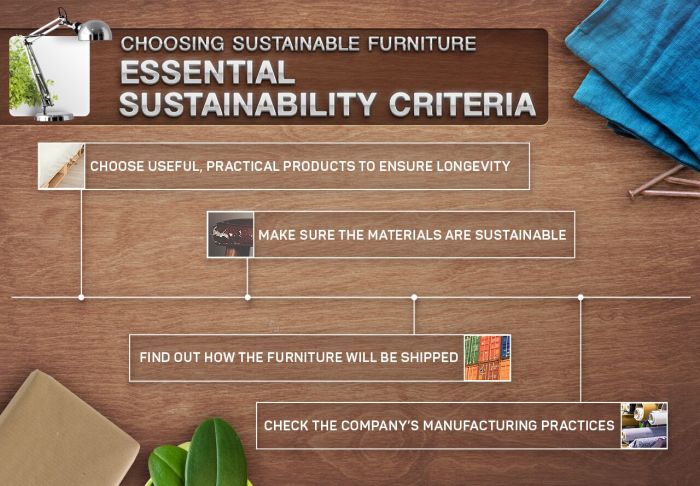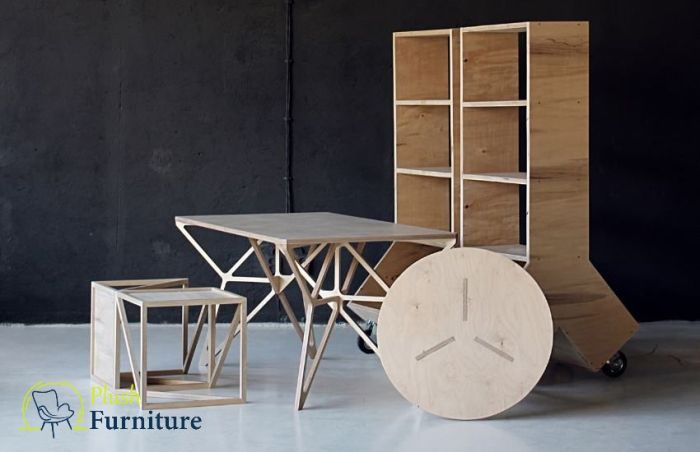Sustainable Materials Transform Furniture Factories, ushering in a new era of environmentally conscious production. This shift encompasses a wide range of considerations, from sourcing sustainable materials to implementing eco-friendly manufacturing processes. The transition presents significant opportunities for furniture factories to enhance their brand image, reduce their environmental footprint, and tap into a growing market segment of environmentally conscious consumers.
This exploration delves into the multifaceted challenges and opportunities associated with the adoption of sustainable materials. From the initial selection of materials to the impact on design, manufacturing, and supply chains, the transformation is far-reaching. The discussion further examines consumer preferences, market trends, and case studies of successful transitions to illuminate the path toward a more sustainable future in the furniture industry.
Introduction to Sustainable Materials

Source: greenmatters.com
The furniture industry is undergoing a significant transformation, driven by increasing awareness of environmental and social responsibility. Sustainable materials are playing a crucial role in this shift, offering a path towards more environmentally friendly and socially responsible manufacturing processes. This approach benefits both the planet and the bottom line for furniture companies.The use of sustainable materials reduces the environmental impact of furniture production by minimizing resource depletion, lowering greenhouse gas emissions, and reducing waste generation.
Socially, it promotes ethical labor practices and fair trade relationships within the supply chain, leading to improved working conditions for those involved in sourcing and manufacturing the materials.
Overview of Sustainable Materials
Sustainable materials in the furniture industry encompass a wide range of resources that are sourced and processed in ways that minimize their environmental footprint. This encompasses everything from the raw materials themselves to the manufacturing processes involved. Key considerations include the material’s lifecycle, from extraction or reclamation to eventual disposal or recycling. Using sustainable materials reduces the overall environmental impact compared to traditional materials.
Examples of Sustainable Materials
A variety of materials are increasingly being recognized for their sustainability credentials in furniture production. Examples include bamboo, reclaimed wood, recycled plastic, and sustainably harvested wood. Each of these materials offers unique advantages in terms of environmental and social responsibility.
Comparison of Sustainable Materials
| Material | Properties | Sourcing | Manufacturing Processes |
|---|---|---|---|
| Bamboo | Fast-growing, strong, lightweight, renewable. Excellent durability and aesthetic appeal. | Cultivated in specific regions, often in a way that minimizes deforestation of other forests. | Typically involves minimal processing, often using water-based finishes to minimize chemical use. |
| Recycled Plastic | Durable, cost-effective, can be molded into various shapes. Reduces reliance on virgin plastic. | Collected and processed from plastic waste, reducing landfill burden. | Involves melting and re-forming the plastic into desired shapes, often with recycled pigments. |
| Reclaimed Wood | Unique character, often with a rich history, reduces demand for new lumber. Lower carbon footprint compared to virgin wood. | Recovered from existing structures or demolition sites. | Requires careful preparation, including sanding and stabilization, to prevent further deterioration. |
| Sustainably Harvested Wood | Offers a balance between economic viability and environmental protection. Preserves forest ecosystems. | Comes from forests managed with responsible forestry practices. | Often involves certified lumber, minimizing negative impacts on forests. |
Impact on Furniture Factories

Source: helpforbusymums.com
Furniture factories face significant challenges in their transition to sustainable materials, yet the potential rewards are substantial. These rewards extend beyond environmental responsibility and encompass economic gains and improved operational efficiency. Understanding these facets is crucial for a comprehensive evaluation of the shift to sustainability.The transition to sustainable materials requires a multifaceted approach, impacting everything from procurement and production to waste management and ultimately, customer perception.
Factories must evaluate not just the materials themselves but the entire supply chain, including sourcing, manufacturing processes, and end-of-life disposal. This necessitates a thorough analysis of existing practices and a commitment to innovation.
Challenges in Adopting Sustainable Materials
Implementing sustainable practices presents numerous challenges for furniture factories. Higher upfront costs for sustainable materials are a significant hurdle. The availability of certified and traceable sustainable sources can be limited, creating sourcing complexities. Educating workforce on new materials and processes, and modifying existing machinery for compatibility with sustainable materials, can be costly and time-consuming. Furthermore, stringent certifications and regulations often accompany sustainable materials, demanding meticulous adherence to standards.
Potential Economic Benefits of Switching
Transitioning to sustainable materials can generate significant economic benefits for furniture factories. Increasing consumer demand for eco-friendly products creates a market advantage, potentially leading to higher sales and premium pricing. Reduced material waste and improved efficiency in production processes can lower operational costs. Companies that adopt sustainable practices can attract environmentally conscious investors and enhance their brand image, fostering loyalty and driving revenue growth.
A successful sustainability strategy can translate to long-term financial gains. Examples of companies successfully implementing sustainable practices in furniture manufacturing demonstrate this potential.
Impact on Production Processes and Supply Chains
Adopting sustainable materials significantly impacts production processes. New processes may be needed to integrate sustainable materials into existing production lines, requiring investments in equipment upgrades. The supply chain must adapt to new sourcing methods and potentially higher costs of certified sustainable materials. This may require closer collaboration with suppliers and stricter quality control measures throughout the supply chain to ensure material integrity and sustainability.
Furthermore, proper waste management systems must be integrated into the production processes to minimize environmental impact and maximize resource utilization.
Steps Involved in Transitioning to Sustainable Materials
Transitioning to sustainable materials requires a systematic approach. Effective implementation depends on careful planning and execution.
| Step | Description | Resource Management/Waste Reduction Strategies |
|---|---|---|
| 1. Assessment and Planning | Thoroughly assess current processes, identify material usage, and establish clear sustainability goals. Analyze the environmental footprint of current materials and processes, and define targets for reduction. | Conduct life cycle assessments of existing materials and processes. Develop a comprehensive inventory of current material usage and waste generation. Identify areas for improvement in resource efficiency. |
| 2. Material Sourcing | Establish relationships with sustainable material suppliers, ensuring traceability and certification. Investigate alternative sustainable materials and compare their properties and costs. | Prioritize locally sourced materials to reduce transportation emissions. Seek out certified sustainable materials from reputable suppliers. Establish clear criteria for sustainable material selection, including environmental impact, social responsibility, and economic viability. |
| 3. Process Modification | Adapt existing production processes to accommodate new sustainable materials. Evaluate the feasibility of modifying equipment and implementing new techniques to ensure optimal material use and minimize waste. | Implement lean manufacturing principles to minimize material waste. Optimize cutting and assembly processes to reduce material loss. Implement closed-loop systems for waste recycling and reuse. |
| 4. Waste Management | Implement effective waste management systems to minimize waste generation and maximize recycling and reuse. | Establish comprehensive waste sorting and recycling programs. Seek opportunities to reuse or repurpose waste materials. Explore partnerships with waste management companies for effective waste handling and recycling. |
| 5. Monitoring and Evaluation | Track progress towards sustainability goals, evaluate the effectiveness of implemented strategies, and identify areas for improvement. | Regularly monitor resource consumption and waste generation. Evaluate the environmental impact of implemented changes and adjust strategies as needed. Document the progress of the transition to sustainable materials. |
Design and Manufacturing Processes
Sustainable furniture design extends beyond aesthetics; it encompasses the entire lifecycle of the product, from material selection to manufacturing and disposal. Thoughtful design choices and sustainable manufacturing processes are critical in minimizing the environmental footprint of furniture production. This section explores how design decisions influence sustainability, the role of eco-friendly manufacturing, and innovative approaches to waste reduction.
Influence of Design Choices on Sustainability
Design significantly impacts the environmental footprint of furniture. Careful material selection, modularity, and repairability are crucial. Designing for disassembly and component interchangeability allows for easier repair, reuse, and recycling at the end of a product’s life. Using readily available, locally sourced, and renewable materials reduces transportation costs and environmental impact.
Sustainable Manufacturing Processes
Sustainable manufacturing processes are vital for minimizing the environmental impact of furniture production. Implementing techniques like reducing water usage in the manufacturing process, using energy-efficient machinery, and adopting closed-loop systems for waste management are key aspects. Minimizing the use of harmful chemicals and solvents in manufacturing reduces pollution and safeguards worker health.
Methods of Sustainable Furniture Production
Various methods contribute to sustainable furniture production. Modular design allows for flexibility and adaptability, reducing material waste and promoting product longevity. Upcycling repurposes existing materials into new furniture pieces, diverting waste from landfills and promoting resource efficiency. The use of 3D printing, for example, offers the potential for customized designs, reduced material use, and localized production.
Innovative Approaches to Waste Reduction and Recycling
Furniture factories can implement innovative strategies to minimize waste. Implementing a comprehensive waste sorting and recycling program is essential. Collaborating with recycling partners to ensure proper disposal of materials, like wood and metal, is critical. Designing furniture components with recyclability in mind, such as using readily separable components or materials, can greatly improve waste management. Exploring bio-based materials and composting programs can further reduce the environmental impact of furniture production.
Examples of Sustainable Furniture Designs
| Furniture Design | Sustainable Materials Used | Environmental Impact |
|---|---|---|
| Modular Sofa Set | Recycled steel frames, reclaimed wood components, and organic cotton upholstery. | Reduced reliance on virgin materials, minimizing landfill waste, and promoting reuse. |
| Upcycled Chair | Recovered wooden pallets, repurposed metal parts, and reclaimed textiles. | Reduces deforestation and waste, creating unique and aesthetically pleasing furniture. |
| Bamboo Bed Frame | Sustainable bamboo wood frame with natural finishes. | Bamboo is a fast-growing renewable resource, requiring less land and water compared to traditional wood. |
| 3D-Printed Desk | Recycled plastic filament, sustainably harvested wood accents. | Reduces material waste by allowing for customized designs and minimizing excess. |
Supply Chain Considerations
Sustainable furniture manufacturing hinges on a robust and ethical supply chain. A critical aspect of this involves sourcing materials responsibly and ensuring transparency throughout the entire process. This necessitates a commitment to environmental and social responsibility, which extends beyond the factory walls to encompass the entire network of suppliers and producers.
Importance of Sustainable Sourcing
Sustainable sourcing of materials is paramount for furniture factories. It minimizes environmental impact, promotes social equity, and safeguards long-term viability. By choosing materials from responsible sources, furniture manufacturers demonstrate a commitment to environmental protection, reducing deforestation, water pollution, and other harmful consequences. Moreover, sustainable sourcing often translates to higher quality materials and enhanced product longevity.
Challenges in Tracking and Verifying Sustainability
Tracking and verifying the sustainability of materials throughout the supply chain presents significant challenges. The complexity of global supply networks, the lack of standardized metrics, and the difficulty in tracing materials from origin to end product can make it difficult to ensure sustainability at every stage. Often, documentation and communication between suppliers are inconsistent, creating gaps in the traceability process.
Transparency and Ethical Sourcing Practices
Transparency and ethical sourcing practices are essential to build trust and ensure accountability in the supply chain. Open communication about material origins, production processes, and labor conditions fosters trust among stakeholders. Ethical sourcing prioritizes fair labor practices, preventing exploitation and promoting equitable compensation for workers throughout the supply chain. This involves scrutinizing the working conditions of individuals involved in the extraction, processing, and transportation of materials.
Role of Certification and Standards
Certifications and standards play a crucial role in verifying the sustainability of materials. Third-party certifications, such as Forest Stewardship Council (FSC) certification for wood or Fairtrade certification for textiles, provide an independent verification of sustainability criteria. These certifications help consumers and manufacturers identify sustainable materials and processes. The adoption of robust industry standards can improve the consistency and effectiveness of sustainable sourcing.
Benefits and Challenges of Sustainable Sourcing Strategies
| Sustainable Sourcing Strategy | Benefits | Challenges | Examples of Successful Partnerships |
|---|---|---|---|
| Forest Stewardship Council (FSC) certified wood | Ensures responsible forest management, reduces deforestation, and promotes biodiversity. | Potential for higher material costs, variability in certification standards across regions. | Furniture manufacturer X partnering with FSC-certified timber suppliers Y and Z, resulting in a significant reduction in their carbon footprint. |
| Recycled and reclaimed materials | Reduces waste, conserves resources, and minimizes environmental impact. | Finding reliable sources of high-quality recycled materials, ensuring consistent quality and availability. | Furniture company A collaborating with a local recycling center to utilize reclaimed wood and metal in their designs, demonstrating a commitment to circularity. |
| Locally sourced materials | Reduces transportation emissions, supports local economies, and fosters stronger community ties. | Limited availability of specific materials, potential for higher costs depending on regional availability. | Furniture manufacturer B partnering with regional artisans and craftspeople to utilize locally sourced timber and fabrics, boosting the local economy and supporting sustainable practices. |
| Organic and Fair Trade materials | Promotes sustainable agriculture, supports fair labor practices, and enhances product quality. | Potential price fluctuations, maintaining consistent quality and sourcing, ensuring transparency throughout the entire supply chain. | Company C working with Fairtrade certified textile suppliers to create stylish and durable upholstery, demonstrating a commitment to both ethical and environmentally conscious practices. |
Consumer Perception and Market Trends

Source: futurecdn.net
Consumers are increasingly aware of the environmental impact of their choices, including the furniture they purchase. This heightened awareness is driving a significant shift in consumer preferences, leading to a growing demand for sustainable furniture options. The market is responding to this demand, with companies seeking to meet the needs of environmentally conscious consumers.
Consumer Preferences for Sustainable Furniture, Sustainable Materials Transform Furniture Factories
Consumers are drawn to sustainable furniture for a variety of reasons. Beyond the environmental benefits, they often appreciate the inherent quality and durability of well-crafted, sustainably sourced pieces. Aesthetic appeal also plays a role, with many consumers finding the design of sustainable furniture to be just as appealing as traditional options. The perceived value proposition of these items, combining environmental responsibility with high quality, is attracting a broad range of customers.
Growing Demand for Eco-Friendly Products
The demand for eco-friendly products across various sectors is on the rise. This trend is fueled by factors like growing public awareness of environmental issues, stricter regulations, and consumer desire to reduce their environmental footprint. The furniture industry is directly impacted by this broader shift. Companies that embrace sustainable practices are likely to attract a larger customer base and gain a competitive edge.
Market Trends for Sustainable Furniture
Data from market research firms consistently shows a positive trajectory for sustainable furniture. Increasing numbers of consumers are willing to pay a premium for products made with recycled materials or from renewable sources. This suggests a growing market segment prioritizing sustainability in their purchases. Further, several established brands are seeing substantial growth in sales of their sustainable lines.
This demonstrates the viability of the sustainable furniture market and its potential for continued expansion.
Role of Marketing and Branding in Promoting Sustainable Furniture
Effective marketing and branding strategies are crucial for promoting sustainable furniture. Companies must effectively communicate their commitment to sustainability, emphasizing the environmental benefits and the quality of their products. Transparency regarding sourcing and manufacturing processes is critical for building trust and credibility with consumers. Strong brand storytelling that resonates with environmentally conscious consumers can be a powerful tool for increasing sales and market share.
Marketing Strategies Employed by Furniture Companies
| Marketing Strategy | Description | Example |
|---|---|---|
| Highlighting Sustainable Materials | Emphasizing the use of recycled, reclaimed, or renewable materials in product construction. | “Our chairs are crafted from sustainably harvested bamboo, reducing our carbon footprint.” |
| Promoting Ethical Sourcing | Showcasing the responsible and fair labor practices employed throughout the supply chain. | “We partner with ethical suppliers who prioritize fair wages and safe working conditions.” |
| Emphasizing Durability and Longevity | Communicating the long-lasting quality of the furniture, reducing the need for frequent replacements. | “Our tables are built to last generations, minimizing waste and maximizing value.” |
| Collaborating with Environmental Organizations | Partnering with NGOs or charities to demonstrate a commitment to environmental conservation. | “We support reforestation efforts by donating a portion of profits from each sale.” |
| Utilizing Eco-Friendly Packaging | Employing packaging made from recycled or renewable materials to reduce waste. | “Our furniture arrives in recyclable packaging, minimizing our environmental impact.” |
These strategies help companies effectively communicate their commitment to sustainability, building trust and attracting environmentally conscious consumers. This alignment of values creates a powerful connection with customers, potentially increasing brand loyalty and market share.
Case Studies of Successful Transformations

Source: yankodesign.com
Several furniture factories have successfully transitioned to sustainable practices, demonstrating the feasibility and benefits of adopting eco-friendly materials and processes. These transformations often involve a multifaceted approach, incorporating various strategies to achieve environmental responsibility and economic viability. These case studies provide valuable insights into the practical application of sustainable materials and offer a roadmap for other factories seeking similar transformations.
Examples of Successful Transitions
Furniture factories have implemented diverse strategies to embrace sustainable practices. One successful example involves a Scandinavian furniture manufacturer that transitioned from traditional wood veneers to locally sourced, reclaimed wood. This decision reduced their reliance on imported materials, lowering transportation costs and their carbon footprint. Another example is a North American company that replaced conventional particleboard with a bio-based composite material made from agricultural waste.
This reduced their reliance on fossil fuels and minimized waste generation.
Strategies Employed by Successful Factories
These factories employed a combination of strategies to achieve their sustainability goals. Key strategies included:
- Material sourcing: Prioritizing locally sourced and recycled materials reduced transportation costs and minimized environmental impact. This included exploring options like bamboo, reclaimed wood, and recycled plastics.
- Manufacturing process optimization: Implementing lean manufacturing principles and reducing waste in the production process. This included improving material efficiency and minimizing energy consumption.
- Supply chain management: Collaborating with suppliers who share similar environmental values, fostering a sustainable supply chain that prioritizes ethical and responsible sourcing practices.
- Product design for recyclability: Designing furniture components with a focus on recyclability and ease of disassembly, allowing for more sustainable end-of-life solutions.
Positive Outcomes and Lessons Learned
Transitioning to sustainable materials and practices yielded several positive outcomes for these furniture factories. They experienced decreased production costs due to reduced material waste, lower energy consumption, and increased operational efficiency. Furthermore, enhanced brand reputation and customer loyalty resulted from aligning with growing consumer demand for sustainable products. A key lesson learned is that implementing sustainability initiatives often requires upfront investment in new technologies and processes, but these investments frequently lead to long-term cost savings and brand enhancement.
Key Performance Indicators (KPIs)
The following table showcases some of the key performance indicators (KPIs) that reflect the success of sustainable transitions in furniture factories:
| KPI | Description | Example Value (Illustrative) |
|---|---|---|
| Reduced Waste | Percentage reduction in waste generated during production | 15% |
| Improved Efficiency | Percentage increase in production output per unit of input | 10% |
| Increased Customer Satisfaction | Percentage increase in customer satisfaction ratings related to sustainability | 8% |
| Energy Consumption Reduction | Percentage decrease in energy usage per unit of output | 12% |
| Carbon Footprint Reduction | Percentage decrease in the factory’s carbon footprint | 18% |
Future Trends and Innovations
The furniture industry is undergoing a significant transformation, driven by increasing consumer demand for sustainable products. This shift necessitates a proactive approach to integrating innovative materials and manufacturing processes. The future of sustainable furniture production hinges on embracing emerging trends and technologies that reduce environmental impact and enhance the lifecycle of products.
Emerging Trends in Sustainable Materials
A multitude of innovative materials are gaining traction in the furniture sector. These materials often offer superior sustainability credentials compared to traditional options. Bio-based polymers derived from agricultural waste, mycelium-based composites, and recycled plastics are examples of materials poised for significant growth. These materials provide an alternative to conventional wood and plastics, minimizing reliance on finite resources.
Role of Technology in Driving Innovation
Technology plays a crucial role in streamlining sustainable furniture production. Advanced 3D printing techniques are enabling the creation of intricate designs with reduced material waste. Digital design tools facilitate material optimization, minimizing the use of raw resources. Furthermore, the use of smart sensors in the manufacturing process allows for real-time monitoring and adjustments, optimizing resource utilization and reducing errors.
Potential of New Materials and Technologies
Emerging materials, like those derived from algae or agricultural byproducts, offer exciting possibilities for sustainable furniture. These materials can potentially replace traditional wood and plastics, offering comparable strength and durability while reducing reliance on fossil fuels. Additionally, advancements in nanotechnology could lead to materials with enhanced performance characteristics and reduced environmental impact.
Circular Economy Models in Furniture
The circular economy concept is gaining momentum in the furniture industry. This involves designing products for disassembly and reuse, promoting product longevity, and facilitating material recovery at the end of a product’s life. Collaborative design approaches involving manufacturers, retailers, and consumers can further promote this model. Implementing a circular economy model requires a shift in the entire value chain, including design, production, distribution, and consumer behavior.
Key Future Trends in Sustainable Furniture
| Trend | Potential Impact |
|---|---|
| Bio-based materials | Reduced reliance on finite resources, lower carbon footprint |
| 3D printing | Customization, reduced material waste, creation of complex designs |
| Circular economy models | Extended product lifespan, resource optimization, minimized waste |
| Smart manufacturing | Real-time monitoring, optimization of processes, reduced errors |
| Advanced design software | Material optimization, design efficiency, reduced material usage |
Closure

Source: plushfurniture.ae
In conclusion, the adoption of sustainable materials by furniture factories is not merely a trend; it’s a crucial step towards a more environmentally responsible and economically viable future. By embracing sustainable practices, factories can improve their operational efficiency, enhance their brand reputation, and respond to growing consumer demand for eco-friendly products. The future of the furniture industry hinges on its ability to adapt and innovate, and this transition represents a critical opportunity for growth and positive change.
Q&A: Sustainable Materials Transform Furniture Factories
What are some common challenges faced by furniture factories when adopting sustainable materials?
Higher upfront costs for sustainable materials, potential supply chain disruptions, and adapting existing production lines to accommodate new materials are common challenges. However, long-term cost savings and improved brand reputation can often offset these initial hurdles.
How can furniture factories track and verify the sustainability of materials throughout their supply chains?
Implementing robust traceability systems, working with certified suppliers, and conducting regular audits can help verify the sustainability of materials. Transparency and ethical sourcing practices are crucial for building trust with consumers and stakeholders.
What are some innovative approaches to waste reduction and recycling in furniture factories?
Implementing modular designs, upcycling materials, and establishing internal recycling programs are some innovative approaches. These strategies can minimize waste and contribute to a more circular economy within the furniture industry.
What are the key performance indicators (KPIs) used to measure the success of sustainable transitions in furniture factories?
Reduced waste generation, improved production efficiency, enhanced resource utilization, and increased customer satisfaction are commonly used KPIs to measure success. These metrics can provide tangible evidence of the positive impact of sustainable practices.